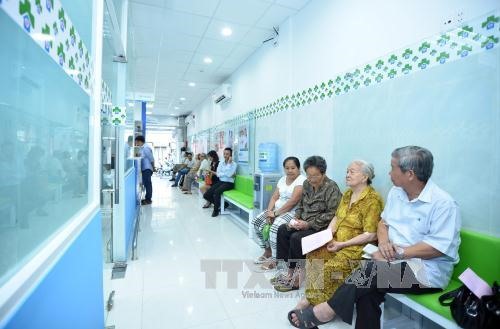 Society
Society

Residents in the outlying district of Thủ Đức in HCM City will be able to access full medical care in the near future as two doctors and a sufficient supply of medicine will be provided to 10 ward-level healthcare stations under a new pilot programme called Health Station-One Stop.
 |
| Patients wait at a ward-level medical station which has received assistance from a public-private partnership to upgrade healthcare services. — VNA/VNS Photo Phương Vy |
Gia Lộc
HCM CITY – Residents in the outlying district of Thủ Đức in HCM City will be able to access full medical care in the near future as two doctors and a sufficient supply of medicine will be provided to 10 ward-level healthcare stations under a new pilot programme called Health Station-One Stop.
The pilot model aims to improve locals’ trust in the medical care offered by ward-level health stations, according to the city’s Department of Health.
Dr Tăng Chí Thượng, deputy head of the department, said the pilot model would help reduce overcrowding of patients at district-, city- and central-level hospitals.
Under the model, doctors at district-level health centres will be rotated at healthcare stations in wards to ensure that two doctors are always available.
Currently, many of the 319 healthcare stations in the city have only one doctor and some have none.
Thượng said the department would issue standard treatment guidelines for healthcare stations in the city, while a list of medical techniques to be used at the 10 participating health stations in the pilot model would be compiled.
District-level hospitals will be instructed to have a sufficient supply of medicine for ward-level healthcare stations, he said.
District hospitals will also receive blood tests and provide test results to healthcare stations within one hour in case the latter are unable to perform the tests.
Under the pilot programme, doctors at district hospitals will be responsible for offering guidance to staff at the healthcare stations.
If the patients need further care, they will be brought to specialised hospitals or district-level ones, according to Thượng.
Hospitals and medical centres will also use IT to link and share their data, while doctors will be allowed to treat the elderly or disabled at their homes.
In the first six months of the year, the number of patients visiting healthcare stations in wards accounted for 3.4 per cent of the city’s total of more than 15.7 million patients. The figure was measured at 3.9 per cent in the same period last year.
“Some patients visiting healthcare stations in Tân Bình District had to return home without being treated because no doctor was there,” said Nguyễn Thanh Trang, head of the District’s Preventive Medicine Centre, which manages the district’s healthcare stations.
Trang spoke at a meeting held in late March with the Ministry of Health in HCM City.
“The district has 10 health stations with one or two doctors. Its five remaining stations have no doctor,” Trang said, adding that the five stations used to have doctors, but they left because of low salaries.
Lê Văn Thể, head of the Health Centre in District 1, said that locals often ignored ward-level stations because they did not provide the same medicine as district-level hospitals.
Last month, Deputy Prime Minister Vũ Đức Đam said he was disappointed when he visited a healthcare station and ordered city authorities to offer them help.
Thượng said the city’s biggest challenge was increasing the level of trust among locals in their ward-level stations.
Thủ Đức District Hospital and Health Centre are responsible for overseeing the pilot model and monitoring the ward stations every month to detect any problems.
Dr Nguyễn Minh Quân, head of Thủ Đức District Hospital, said the hospital was ready to provide technical assistance to relieve overcrowding at his facility.
“The overcrowding at my hospital affects quality and can damage the brand name that took years to build. Hospital-acquired infections can also occur more easily because of overcrowding,” he said.
“I believe that services in wards and communes will attract a large number of patients in the next three years,” Quân added.
Currently, there are two other pilot healthcare models, including a general health clinic and public-private partnership model at several health stations in districts 3, Thủ Đức and Tân Phú. —VNS




